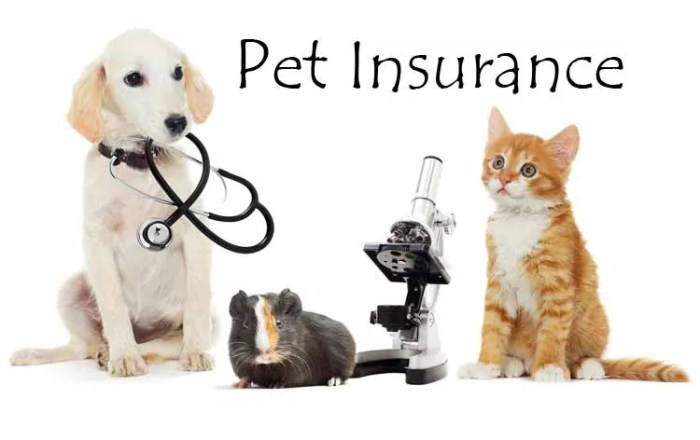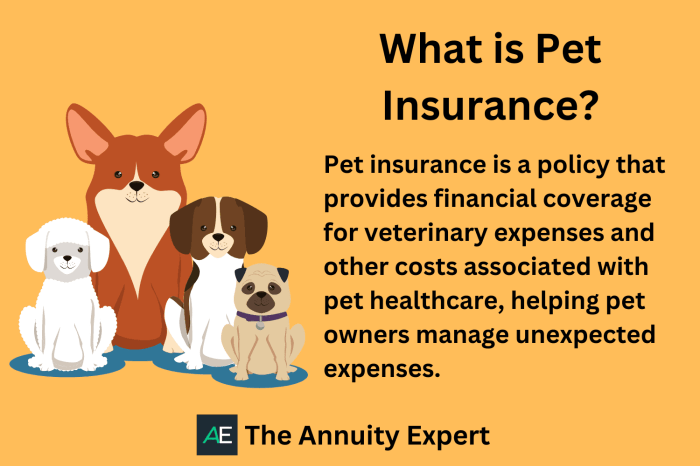Pet insurance for families offers a crucial safety net, shielding against the often-unexpected and substantial costs of veterinary care. This guide explores the various types of pet insurance plans available, helping families navigate the complexities of choosing the right coverage for their beloved companions. We’ll delve into the financial benefits, the impact on family decision-making, and ultimately, how pet insurance contributes to responsible pet ownership and peace of mind.
Understanding pet insurance is key to responsible pet ownership. From comparing different plan types and providers to budgeting for pet healthcare, this guide provides a practical framework for families to make informed decisions. We’ll examine factors influencing premium costs, highlight common exclusions, and offer real-world examples to illustrate the value of pet insurance in mitigating financial burdens associated with pet illnesses or injuries.
Types of Pet Insurance for Families

Choosing the right pet insurance plan can significantly impact your family’s financial well-being in the event of a pet’s illness or injury. Understanding the different types of coverage available is crucial for making an informed decision. This section will Artikel the various plans, their associated costs, and the factors influencing premiums.
Pet Insurance Plan Comparison
Pet insurance plans vary considerably in the level of coverage they offer. Choosing the right plan depends on your pet’s breed, age, health history, and your budget. The following table compares three common plan types:
| Plan Type | Coverage Details | Premium Range (Monthly Estimate) | Pros/Cons |
|---|---|---|---|
| Accident-Only | Covers only accidents, such as broken bones, lacerations, and ingestion of foreign objects. Does not cover illnesses or pre-existing conditions. | $10 – $30 | Pros: Low cost. Cons: Limited coverage; doesn’t cover most common health issues. |
| Accident and Illness | Covers both accidents and illnesses, including many common conditions such as infections, allergies, and certain chronic diseases. May have exclusions for pre-existing conditions. | $30 – $70 | Pros: Broader coverage than accident-only plans. Cons: More expensive than accident-only; pre-existing conditions usually excluded. |
| Comprehensive | Offers the most extensive coverage, including accidents, illnesses, routine care (e.g., vaccinations, dental cleanings), and sometimes even alternative therapies. Specific coverage varies widely between providers. | $50 – $150+ | Pros: Most comprehensive coverage, peace of mind. Cons: Highest premiums; may still exclude pre-existing conditions. |
Factors Influencing Pet Insurance Costs
Several factors significantly impact the cost of pet insurance premiums. These factors are considered by insurance companies to assess the risk associated with insuring a particular pet.
| Factor | Impact on Premiums | Example |
|---|---|---|
| Breed | Certain breeds are predisposed to specific health issues, leading to higher premiums. | A German Shepherd (prone to hip dysplasia) will likely have higher premiums than a mixed-breed dog. |
| Age | Younger pets generally have lower premiums than older pets, as the risk of illness increases with age. | A one-year-old cat will typically have lower premiums than a ten-year-old cat. |
| Pre-existing Conditions | Pre-existing conditions are generally not covered by pet insurance. | A dog diagnosed with diabetes before obtaining insurance will not have that condition covered. |
Reimbursement vs. Indemnity Pet Insurance
The two main types of pet insurance reimbursement structures are reimbursement and indemnity. Understanding the difference is essential for choosing the plan that best suits your needs.
Reimbursement plans reimburse a percentage of your veterinary bills, usually after you’ve paid the bill upfront. For example, an 80% reimbursement plan would pay 80% of your vet bill, leaving you to pay the remaining 20%. Indemnity plans, on the other hand, pay a fixed amount per condition or per day, regardless of the actual cost of treatment. This fixed amount is predetermined by the policy. For instance, an indemnity plan might pay $500 for a specific surgery, regardless of the actual cost of that surgery at your chosen veterinary clinic. Therefore, the choice between these two plan types depends on your risk tolerance and financial preparedness.
Choosing the Right Pet Insurance Plan

Selecting the right pet insurance plan can feel overwhelming, but a methodical approach simplifies the process. Understanding your pet’s needs and your budget are crucial first steps towards finding comprehensive and affordable coverage. This section provides a step-by-step guide to help families navigate the selection process effectively.
A well-chosen pet insurance plan provides peace of mind, knowing that unexpected veterinary bills won’t strain your finances. By carefully considering the factors Artikeld below, you can find a plan that offers the best balance of coverage and cost.
Step-by-Step Guide to Selecting a Pet Insurance Plan
This guide Artikels a practical approach to choosing a pet insurance plan that best suits your family’s needs and your pet’s health profile. Each step is crucial in ensuring you make an informed decision.
- Assess your pet’s health and breed predispositions: Consider your pet’s age, breed, and any pre-existing conditions. Certain breeds are prone to specific health issues, influencing the level of coverage needed.
- Determine your budget: Pet insurance premiums vary widely. Establish a realistic budget before comparing plans to avoid sticker shock later.
- Compare coverage options: Explore different plans, focusing on the types of coverage offered (accident-only, accident and illness, comprehensive). Pay close attention to reimbursement percentages and annual limits.
- Read the policy documents carefully: Don’t just skim the marketing materials. Thoroughly review the policy wording to understand exclusions, waiting periods, and claim processes.
- Check customer reviews and ratings: Research different insurers online. Look for feedback on claim processing speed, customer service responsiveness, and overall satisfaction.
- Choose a reputable insurer: Select a financially stable company with a proven track record of paying claims promptly and fairly.
Key Considerations When Comparing Pet Insurance Providers
Choosing a pet insurance provider requires careful consideration beyond just the premium cost. Several key factors influence the overall value and reliability of a provider.
- Customer Reviews: Online reviews from other pet owners offer valuable insights into a provider’s claim processing efficiency, customer service responsiveness, and overall satisfaction. Look for consistent patterns in feedback, both positive and negative.
- Claims Process: Understand the provider’s claim submission process. A straightforward and efficient process minimizes hassle during stressful times. Inquire about required documentation, turnaround times, and payment methods.
- Financial Stability: Choose a financially sound and reputable company. A financially unstable provider might struggle to pay out claims, leaving you with unexpected costs. Research the insurer’s financial ratings and history.
Common Exclusions and Limitations in Pet Insurance Policies
It’s crucial to understand the limitations of pet insurance policies. Most policies exclude certain conditions or treatments. Reviewing these exclusions is vital before committing to a plan.
- Pre-existing conditions: Most policies won’t cover conditions that existed before the policy started.
- Routine care: Annual checkups, vaccinations, and preventative medications are usually not covered.
- Breed-specific conditions: Some policies may exclude or limit coverage for conditions common in certain breeds.
- Dental care (often): Dental issues are frequently excluded or only partially covered, especially for pre-existing conditions.
- Experimental treatments: Unproven or experimental treatments are typically not covered.
- Waiting periods: There’s usually a waiting period before coverage begins for specific conditions (e.g., illness).
Financial Aspects of Pet Insurance

Pet insurance offers significant long-term financial advantages for families, primarily by mitigating the considerable costs associated with unexpected veterinary care. The unpredictable nature of pet health issues makes budgeting for these expenses challenging, but pet insurance provides a safety net, allowing for proactive financial planning and peace of mind.
Pet insurance helps families budget for pet healthcare expenses by providing a predictable monthly premium in exchange for coverage of a wide range of veterinary services. This predictable cost allows for better financial planning, preventing unexpected veterinary bills from disrupting household budgets. Instead of facing potentially crippling veterinary costs, families can budget the monthly premium, ensuring they can afford necessary care without sacrificing other financial priorities.
Predictable Monthly Costs vs. Unpredictable Veterinary Bills
The core benefit of pet insurance lies in its ability to transform unpredictable, potentially massive veterinary bills into manageable monthly payments. Consider a scenario where a family’s beloved dog, a Golden Retriever named Max, suddenly suffers a serious leg injury requiring surgery and extensive rehabilitation. Without pet insurance, the total cost could easily reach tens of thousands of dollars, potentially forcing the family to make difficult financial choices, such as depleting savings or incurring significant debt. With pet insurance, however, a significant portion of these costs would be covered, leaving the family to manage only a smaller co-pay or deductible, thereby significantly lessening the financial strain. For example, if the total veterinary bill was $15,000 and the policy covered 80% of the costs with a $500 deductible, the family’s out-of-pocket expense would be only $3,500 instead of the full $15,000. This difference can be substantial, allowing families to prioritize Max’s health without jeopardizing their financial stability.
Long-Term Savings and Financial Security
Over the long term, the cumulative savings from pet insurance can be considerable. While the monthly premiums represent an ongoing expense, they are significantly smaller than the potential cost of treating a major illness or injury. Moreover, pet insurance fosters preventative care, allowing owners to address smaller health issues early on, preventing them from escalating into more expensive problems later. Regular check-ups, vaccinations, and early detection of potential health problems are all made more accessible and financially feasible through insurance coverage. This proactive approach contributes to a healthier pet and long-term cost savings.
Budgeting for Pet Healthcare: A Practical Example
Imagine a family with a cat named Luna. They choose a pet insurance plan with a monthly premium of $50. This predictable cost is easily integrated into their monthly budget. Later, Luna unexpectedly develops a urinary tract infection requiring hospitalization and medication. The total veterinary bill is $1,200. With 70% coverage and a $100 deductible, the family’s out-of-pocket expense is only $430, a manageable amount compared to the full cost. This demonstrates how pet insurance allows for better budgeting and peace of mind, knowing that unexpected veterinary expenses will not derail their financial plans.
Pet Insurance and Family Dynamics
Pet insurance significantly alters how families approach pet care decisions, influencing financial planning, treatment choices, and overall pet well-being. The presence or absence of insurance directly impacts the level of stress experienced by families during pet health crises.
Pet insurance fundamentally reshapes family decision-making around veterinary care. Families with insurance are more likely to pursue advanced diagnostic testing and treatment options, even for costly procedures, as the financial burden is significantly reduced. Conversely, families without insurance may face difficult choices between necessary care and financial constraints, potentially leading to delayed or forgone treatment. This can lead to compromised pet health and increased long-term costs.
Pet Insurance Fosters Responsible Pet Ownership
Pet insurance encourages responsible pet ownership by removing a significant barrier to accessing necessary veterinary care. Knowing that unexpected veterinary bills are covered can alleviate the financial stress associated with pet illness or injury, allowing families to focus on their pet’s recovery rather than worrying about mounting debt. This proactive approach to pet health is a key component of responsible pet ownership. A family equipped with pet insurance is better positioned to provide preventative care, such as regular checkups and vaccinations, knowing that more serious health issues will be financially manageable. This contrasts with situations where families, facing financial uncertainty, may delay or forgo preventative care, potentially leading to more serious and costly problems later.
The Emotional Impact of Pet Insurance on Families
The emotional benefits of pet insurance are substantial, particularly during times of crisis. Facing a serious pet illness or injury is inherently stressful. The added financial worry associated with high veterinary bills can significantly exacerbate this stress, creating anxiety and potentially impacting family relationships. Pet insurance acts as a safety net, reducing this financial pressure and allowing families to focus on their pet’s emotional and physical well-being. This emotional support is invaluable, ensuring that families can prioritize their pet’s health without the added burden of significant financial strain. For example, a family whose dog requires emergency surgery can focus on their pet’s recovery knowing the financial aspect is handled, leading to a more positive and less stressful experience for both the pet and the family.
Illustrative Examples
Understanding the financial implications of pet ownership is crucial for responsible pet parenting. Pet insurance can significantly impact these costs, offering a safety net against unexpected veterinary expenses. The following examples illustrate the potential benefits.
Let’s explore how pet insurance can make a tangible difference in managing veterinary costs. We’ll compare scenarios with and without insurance coverage to highlight the potential financial burden without it.
Cost Comparison: Ear Infection Treatment
Imagine your beloved Golden Retriever, Gus, develops a severe ear infection. Without pet insurance, the initial veterinary visit, diagnostic tests (including ear swabs and possibly blood work to rule out underlying conditions), medication (antibiotics and ear cleaning solutions), and follow-up appointments could easily cost between $500 and $1500. This estimate is based on average veterinary costs in the United States, which can vary widely depending on location and the severity of the infection. A visual representation would be a simple bar graph. One bar would represent the cost without insurance ($500-$1500), depicted in a shade of red to signify expense. The other bar, representing the cost *with* insurance, would be a much shorter bar (perhaps $100-$300, depending on the policy’s deductible and co-pay), displayed in a calming green to symbolize cost reduction. The difference between the two bars visually emphasizes the significant financial burden that pet insurance alleviates.
A Happy Family with Their Pet: Peace of Mind, Pet insurance for families
The image depicts a family – a mother, father, and two children – laughing and playing in their backyard with their energetic Labrador Retriever. The dog is happily chasing a ball, and the children are giggling as they try to catch it. The parents are smiling warmly, watching the scene unfold. The overall atmosphere is one of joy, connection, and carefree fun. The subtle inclusion of a pet insurance policy document tucked into the father’s back pocket, barely visible, would subtly represent the underlying peace of mind that pet insurance provides. This peace of mind allows the family to focus on enjoying their pet without the constant worry of potentially crippling veterinary bills should an accident or illness occur. The scene conveys a feeling of security and happiness, directly linked to the financial protection offered by pet insurance. The bright sunlight, vibrant colors of the clothing and the lush green grass further contribute to the feeling of happiness and well-being, highlighting the positive impact of pet insurance on the family’s overall quality of life.
Securing pet insurance is an investment in your pet’s well-being and your family’s financial stability. By carefully considering the various plan options, understanding the associated costs, and choosing a reputable provider, families can confidently navigate the challenges of pet healthcare. The peace of mind offered by knowing your pet will receive the necessary care, regardless of the cost, is invaluable. Ultimately, responsible pet ownership includes proactive planning for potential health issues, and pet insurance plays a vital role in this process.
Questions and Answers
Can I get pet insurance for a pet with pre-existing conditions?
Generally, pre-existing conditions are not covered. However, some insurers may offer limited coverage after a waiting period, so it’s crucial to check individual policy details.
What is the claims process like?
The claims process varies by provider but typically involves submitting veterinary bills and completing a claim form. Review the provider’s specific procedures before purchasing a policy.
How do I choose between reimbursement and indemnity plans?
Reimbursement plans pay a percentage of veterinary bills, while indemnity plans pay a fixed amount per condition. The best choice depends on your budget and risk tolerance.
Are there age limits for pet insurance?
Yes, most insurers have age limits, typically refusing coverage for senior pets. Some may offer limited coverage for older animals, but this varies widely.
What happens if I switch pet insurance providers?
Switching providers usually requires starting a new policy with the new insurer. Pre-existing conditions from the previous policy will generally not be covered.
